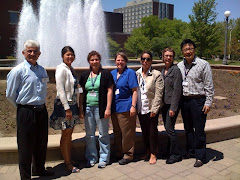Hi everyone!
I'm so excited to be able to share my experience in the Podcasting in Higher Education Learning Team. Podcasting can be described as "m-learning," or "mobile learning." Podcasting borrows from the new and the old; the new being the iPod technology, and the old, a 100-year old technology, broadcasting. When students access your podcasts they are subscribing to a "feed." This means that they only need to subscribe one time to continue to get your content. Podcast is the term that is used for the "course." Each course will then have a series of "episodes" that are all part of the particular course.
One thing that you need to be aware of is your content. Is it credible? Is it appropriate? One must be PARTICULARLY careful that the property is ONE'S OWN. You cannot send out anyone else's material in a podcast. One of the great features of podcasts is that you can begin and end them with music. HOWEVER, you CANNOT use music that is copyrighted. Music must be ROYALTY-FREE, and there is plenty of free material available. Along the same lines, you must consider whether or not you want your creative material "out there." Once you put your teaching online, it is there--forever. In other words, if you create a teaching method that is innovative in your podcast, you have to ask yourself if it is something that you really want to share. If you're not okay with your technique being borrowed in the future, then perhaps podcasting is not for you.
Yet the possibilities are limitless. Podcasts can be used for guest lectures, debates, virtual field trips. You can create "precasts" and introduce upcoming material, or "postcasts" summarizing what was learned. Keep in mind, however, that it is not just the message that is important; it's how the message is delivered.The recording must capture the instructor's enthusiasm. In order to best portray your enthusiasm it is a good idea to have a script for your podcasts. Your script can become your transcript of the podcast and posted as a written record of what you said. Develop your own podcast style, and your students will appreciate that you went to the trouble. Come up with a good instructional design, and give students measurable objectives.Technologies associated with podcasting are vodcasting, or video casting, screencasting, which records everything that happens on a computer, profcasting, which combines audio and powerpoint, and WIMBA, which allows for instruction in a synchronous electronic classroom.
Stay tuned,
Michelle
Monday, May 18, 2009
Subscribe to:
Post Comments (Atom)

No comments:
Post a Comment